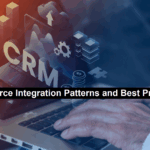
The current business environment depends on Salesforce as its vital platform for customer relationship management and sales achievement. Salesforce’s full effectiveness rises exponentially by integrating with essential business systems.
Salesforce integration requires more than data transfer because it enables business systems to unite into a unified solution, which optimizes operations and improves data accessibility to provide exceptional customer experiences. I am a veteran of Salesforce CRM consulting, and I have seen directly how properly implemented integrations create powerful changes to operations. The integration planning process determines whether the system operates as a connected platform or produces isolated data collection points and dissatisfied users.
This post explores Salesforce integration patterns and best practices that will guide businesses who want to maximize the benefits of their Salesforce deployment:
Understanding the Need for Salesforce Integration
First, we need to understand the reasons behind the approach before studying implementation strategies. Why should integrating Salesforce with other systems constitute a vital part of business operations? You can find the solution through the elimination of data silos combined with a complete business perspective. Consider these key benefits:
- Integrating systems creates automatic data entry elimination between multiple platforms, which guarantees enhanced accuracy and consistent information.
- Automation integration for system data exchange enables strategic business advancement by freeing resources organizations can redirect to mission-critical projects.
- Integrating Salesforce with marketing automation, ERP, and additional business systems can give you complete insight into customer interactions.
- Through this access, stakeholders who access unified data can make better decisions because they obtain actionable insights.
- The connection between lead generation and sales and fulfillment systems produces streamlined data management, allowing sales staff to dedicate themselves to sales activities instead of administrative work.
Key Salesforce Integration Patterns
Successful projects need the proper selection of integration patterns at their core. Different integration needs and complexities can be addressed through multiple established pattern options. The most typical integration patterns include these four:
- When using Request-Reply, the system transmits a request to Salesforce and receives an immediate response. This pattern works best for obtaining and validating real-time data. A customer service portal should verify product availability in Salesforce before finishing order confirmation.
- The batch processing approach entails processing large volumes of data through pre-defined time intervals. Nightly data synchronization between Salesforce and an ERP system fits this pattern because it combines well with tasks that require inventory updates or financial reconciliation.
- The messaging approach uses event-driven communication to execute asynchronous communication through message exchanges between systems. One system (in this case, Salesforce) produces events such as new lead creation, which generates notifications to perform actions in connected systems. The framework operates with excellent scalability and maintains loose interdependence between its elements.
- Data Replication serves as a pattern to duplicate data between systems, mainly for data warehouse preparation and reporting needs. The synchronization process works as a one-way or two-way method but requires thorough attention to data consistency and resolving conflicts between systems.
- Remote Process Invocation serves as a pattern that enables Salesforce to initiate real-time program execution in external systems. The system allows Salesforce to start third-party financial system credit check processes as sales opportunities progress to specific stages.
The selected pattern determines the size of the data volume, update frequency, real-time requirements, and complexity of integration processes. Buildings of various pattern types frequently exist in unified integration solutions.
Read: Cyber Security in Healthcare: The Methods & Importance of Medical Data Protection
Essential Best Practices for Salesforce Integration
The integration of the Salesforce requires more than selecting a pattern for success to emerge. The use of best practices creates systems that resist failure and simultaneously grow and stay easy to maintain. Here are some key considerations:
- The initiation of any integration requires businesses to establish precise requirements, including data figures and expected results, schedule details for exchange processes, and concrete objective definitions. The achievement of successful projects depends on a clearly defined scope.
- The integration process must include selecting specific Salesforce tools, including REST, SOAP, and Bulk APIs with MuleSoft or Dell Boomi middleware solutions and pre-built connectors. The selection process must also consider the organization’s technical abilities and price range, with project complexity as an additional factor.
- Systems need to establish secure data exchange protocols that follow all applicable regulatory requirements. The system requires implemented authentication functions, authorization measures, and encryption systems. Adequate data governance policies need to be implemented to maintain data integrity.
- As your business grows, you should design an integration system for continuous expansion and improved processing speed. Text Utils provides scalable integration design features that maintain system efficiency while accommodating higher data amounts and transaction operations.
- The system requires strong error handling systems and continuous monitoring, so data remains whole and operational stability stays preserved. Essential continuous alerting and monitoring processes enable proactive trouble detection and remedy.
- Compliance standards and performance guidelines set by Salesforce must be followed because API usage and data loading operations must stay within limits to prevent system breakdowns.
- The integration process requires strong testing at different points because complete validation before deployment becomes critical to identifying and fixing any emerging problems. The testing stages consist of unit testing and integration testing, followed by user acceptance testing.
- All integration design elements and configuration details, as well as the data mapping process and error handling protocols, should be documented in complete detail. The documentation will be vital for maintaining systems, identifying problems, and passing information between personnel.
- When dealing with complex integrations, you should apply an iterative process that breaks down the project into smaller and manageable phases. The early feedback mechanism reduces large-scale failures and provides feedback at an early stage.
- Wind tunnel testing should include systems that can change easily while meeting evolving business needs and system changes. You should prevent integrations with tight connectivity because they produce challenges when modifications need to occur.
Conclusion: Building a Connected Future with Salesforce
Businesses seeking operational enhancement, customer relationship improvement, and growth should view Salesforce integration as a critical business strategy. Organizations can create a perfectly integrated ecosystem by using different integration patterns and best practices, unlocking the potential of their Salesforce platform. I recommend all consultants begin integration projects by creating detailed plans, including best practice strategies and defined business goals. The organization will develop into a more efficient operation that uses data for decision-making and customer focus to succeed in the digital era.






